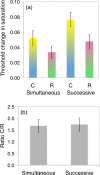What is white?
- PMID: 26641948
- PMCID: PMC4675320
- DOI: 10.1167/15.16.5
What is white?
Abstract
To shed light on the perceptual basis of the color white, we measured settings of unique white in a dark surround. We find that settings reliably show more variability in an oblique (blue-yellow) direction in color space than along the cardinal axes of the cone-opponent mechanisms. This is against the idea that white perception arises at the null point of the cone-opponent mechanisms, but one alternative possibility is that it occurs through calibration to the visual environment. We found that the locus of maximum variability in settings lies close to the locus of natural daylights, suggesting that variability may result from uncertainty about the color of the illuminant. We tested this by manipulating uncertainty. First, we altered the extent to which the task was absolute (requiring knowledge of the illumination) or relative. We found no clear effect of this factor on the reduction in sensitivity in the blue-yellow direction. Second, we provided a white surround as a cue to the illumination or left the surround dark. Sensitivity was selectively worse in the blue-yellow direction when the surround was black than when it was white. Our results can be functionally related to the statistics of natural images, where a greater blue-yellow dispersion is characteristic of both reflectances (where anisotropy is weak) and illuminants (where it is very pronounced). Mechanistically, the results could suggest a neural signal responsive to deviations from the blue-yellow locus or an adaptively matched range of contrast response functions for signals that encode different directions in color space.
Figures






References
-
- Abramov, I.,, Gordon J. (1994). Color appearance: on seeing red—or yellow, or green, or blue. Annual Review of Psychology, 45, 451–485. - PubMed
-
- Ayama M.,, Nakatsue T.,, Kaiser P. K. (1987). Constant hue loci of unique and binary balanced hues at 10, 100, and 1000 Td. Journal of the Optical Society of America. A, Optics and Image Science, 4, 1136–1144. - PubMed
-
- Beer D.,, Wortman J.,, Horwits G.,, MacLeod D. (2005). Compensation of white for macular pigment filtering. Journal of Vision, 5 (8): 5 doi:10.1167/5.8.282 [Abstract]
-
- Berlin B.,, Kay P. (1969). Basic color terms: Their universality and evolution. Berkeley: University of California Press.
-
- Bosten J.,, Lawrance-Owen A. (2014). No difference in variability of unique hue selections and binary hue selections. Journal of the Optical Society of America. A, Optics, Image Science, and Vision, 31, A357–A364. - PubMed
Publication types
MeSH terms
Grants and funding
LinkOut - more resources
Full Text Sources
Other Literature Sources
Molecular Biology Databases

